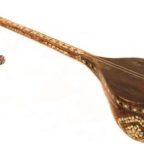Traditional methods of processing and playing the Dotar
Included in 2019 in the UNESCO list of Intangible Cultural Heritage of Humanity
Traditional methods of processing and playing the Dotar define one of the most important social and cultural components of folkloric music among various ethnic groups and Iranian communities. The makers of this instrument are the artisans mostly men farmers and female players. The Dotār is a folkloric musical instrument with a pear-shaped bow made of mulberry wood, an apricot or walnut wood neck and two strings. One string is believed to be male and function as the chord, while the other is female, playing the main melody. The instrument is played on important social and cultural occasions such as weddings, parties, celebrations and ritual ceremonies. In recent years this instrument has been presented on various occasions such as national and international festivals. The musicians as they play tell epic, historical, lyric and gnostic narratives that are at the heart of their ethnic history, pride and identity. The traditional art related to the reproduction of the Dotār are passed down informally through the pupil master method, which reflects the history and background of the artists. A tool that promotes peaceful coexistence, mutual respect and understanding both between different communities and with neighboring countries.

